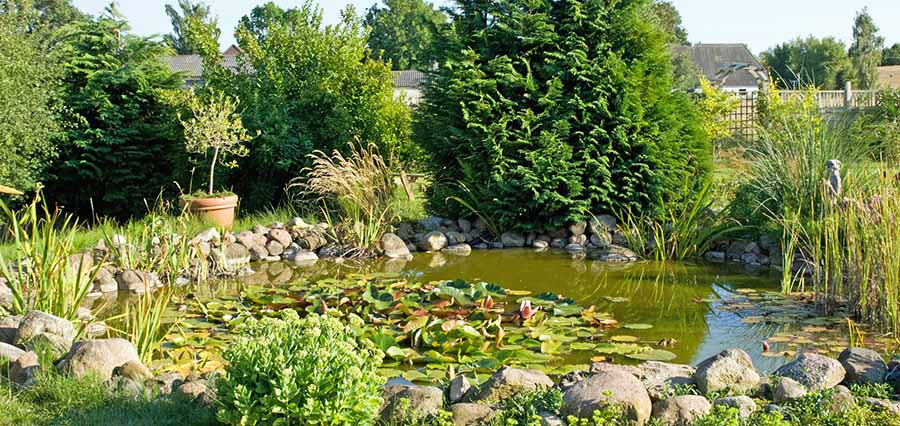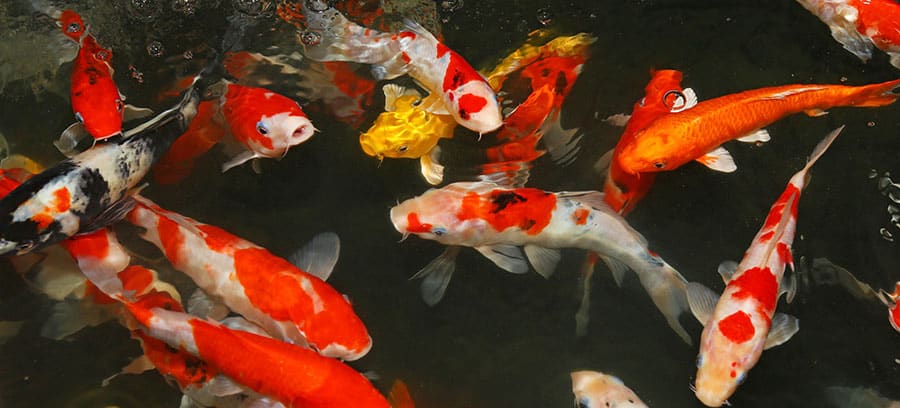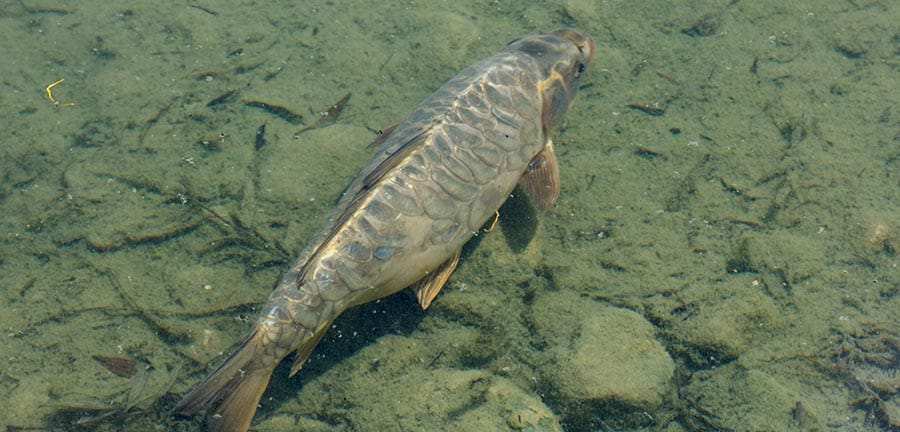A pond filter can help you keep your pond clear and clean smelling, but if it isn’t maintained properly, the filter can quickly become stopped up with sludge and other debris. Eventually, this can even lead the pump to become burned out and stop functioning completely. This can be a costly hassle to deal with, especially if you have fish that are dependent on your pond’s filtration system for survival.
There are several steps you can take to prevent your pond filter from clogging, and most of them involve routine maintenance tasks that should be performed either daily, weekly, or by the season. Below you’ll find all the steps necessary for you to keep your pond’s filter in tip-top shape from spring through winter.
Do Daily Inspections on Your Pond
This advice can seem tedious—nobody wants to have to “inspect” anything daily. But an inspection of your pond shouldn’t be a chore. You should enjoy every opportunity to go out and look at your pond since you are going through the trouble to keep it looking nice.

It doesn’t have to be an in-depth inspection, but checking out your pond daily to see how things are doing goes a long way toward preventing it from clogging. Often, when a pond filter clogs up, it is the result of several weeks’ worth of neglect rather than an overnight problem. Therefore, if you go out of your way to check your pond each day and look for problem areas, you can often get things straightened out before they snowball out of control.
The major advantage of getting into the habit of doing daily checks of your pond is that if you keep your pond up regularly in this way, missing a day or two here and there shouldn’t negatively impact the performance of the pond’s filtration. But if you let a day or two slide into several days or even a few weeks, you may end up with a bigger maintenance mess on your hand than you bargained for.
Here are some of the things you should look for when inspecting your pond:
- Build-up of debris such as twigs and leaves: This kind of incremental build-up can be the easiest to remove, and swiping a net over the surface of your pond as you see things fall into it from day to day can go a long way toward preventing the build-up of decaying material on the bottom of the pond that can end up clogging the filter.
- Bottom sludge: Bottom sludge in a pond is created from a combination of fish waste, decaying plant matter, algae, and other organic materials. If left unchecked, the build-up of bottom sludge can eventually lead to the clogging of the filtration system.
- Fish activity: While you’re out there checking out the filtration, notice if your fish are active and feeding, or are they hiding? Fish that are constantly in hiding are often a symptom of herons or other predators that are stalking the pond. Daily inspections can not only help you prevent filtration issues, but they can also allow you to observe the behavior of your aquatic animals.
- Dead or missing fish: Keeping an eye on your pond fish daily means that if one of them goes missing or dies, you’ll know right away. Removing a dead fish quickly can not only prevent the build-up of deadly ammonia in the pond community, but it can also prevent the corpse of the fish from clogging the pond filter after being pulled in by the intake.
- Lack of water current: One of the advantages of checking your pond every day is that you can notice if there’s any reduction in water current that may point to a developing clog in the filtration system. Catching these kinds of things early makes them much easier to fix than waiting until the filter is so clogged that it can’t operate at all.
Get Some Algae Eaters to Help Your Pond Filter
Another step you can take towards keeping your pond filter clear is to employ the help of algae-eating fish and other aquatic animals, such as pond snails. Not only do these animals give you some action to look at when you observe your pond, but they can also help keep your pond clear of algae that can eventually lead to pond scum and filtration problems.
Here are some fish species that can help you control the algae in your pond:
- Common Pleco
- Koi
- Pond Loach
- Guppy
- Siamese Algae Eater

Algae eaters help keep algae from building up that can ultimately lead to a clog in your filtration system, and they help to improve the water quality, leaving your pond sparkling clean and clear so that you have the best visibility to see your fish and plants.
Keep Your Pond Filter Running to Keep It Clear
One issue that can crop up with a clogged pond filter is when people use their pond filters intermittently to try to save money on utilities. If you turn your pond filter off periodically, this can cause a back-up of debris into the filter that can ultimately lead to it becoming stopped up.
To keep your filter clear, it’s a better option to run your pond filter continuously to keep it clear of debris. While this may end up costing more in utilities on the pump, the time and energy it will save you in keeping it operational and preventing you from having to dismantle and clean it will be well worth the money.
Winterize Your Pond Each Year
Another step that you need to take towards keeping your pond’s filter unclogged is to winterize the pond each year. Winterizing the pond helps prevent the build-up of dead plant material and sludge in the pond that accumulates over the winter months and causes pumps to malfunction in the spring.

Here are some steps you can take to winterize your pond at the end of every autumn to ensure that your pond is clean and clear in the spring:
- Remove all dead leaves and other debris. These factors are the greatest contributors to a build-up of sludge and other organic debris in the pond throughout the winter. This decayed material is one of the major causes of a clogged pond filtration system.
- Trim away any dead or dying marginal plants that would die back in cold weather and end up rotting on the bottom of the pond.
- Supplement your pond’s ecosystem with cold water bacteria. Colder winter weather will kill off much of the beneficial bacteria in your pond that is responsible for breaking down organic matter in the water, but adding cold water bacteria will provide bacteria that can break down the organic matter in its place.
Taking these three measures can help a lot with preventing the build-up of sludge in your pond that will eventually lead to a filtration problem.
Keep the Pond Filter Skimmed Out
This task falls more under weekly maintenance, but making sure to keep your pond’s filter skimmed out at least once or twice a week can prevent your pond’s filter from developing a clog. Removing this debris a little at a time keeps it from accumulating to the kinds of levels that completely stop the water from flowing through the intake.
The other advantage of keeping things out of the pond filter is that it means less organic material has a chance to rot in the water, which is the cause of the foul-smelling sludge that many pond owners report having to deal with on the bottom of their ponds without proper maintenance of the plants and the water.
Problems like this are usually much easier to solve through a little preventative maintenance than by having to fix them directly, so it’s worth taking the extra time to make sure the pond filters stay clear.
Keep the Pump Intake Cleaned Out
Along with the pond filter, another area of the pond that tends to accumulate debris that can clog the filtration system is the pump intake. To prevent this from happening, it’s a good idea to check your pump’s intake whenever you check your pond filter to see if any debris needs to be removed.
Remember that it’s always easier to take a few minutes to do this a little at a time than it is to have to shut down your pump to scrub it out.
Make Sure Not to Overstock Your Pond
While having pond fish is one of the greatest joys of having a pond in your yard, you have to be careful not to go overboard when it comes to stocking your pond with too many animals.
The more animals you have, the more waste that they’ll release into the water. Without strong enough filtration, this waste will gradually accumulate in the pond, causing it to develop a sludgy bottom. This sludge is difficult for the pond filtration system to pick up, and if it does break off into the filtration system, it can often cause a clog.
Before buying animals for your pond, be sure to look up a stocking calculator to figure out how many fish you can reasonably have for the amount of water that you have in your pond.
Keep in mind that it’s always better to understock the pond to allow some buffer in case there is a death that causes an ammonia spike or some other sudden shift in the water parameters. Keeping ponds stocked too close to their limit can cause a system crash if something gets thrown out of whack.
Remove Pond Sludge on the Bottom of the Pond
A major cause of pond filtration clogs is pond sludge, which is thick biomass that can form on the bottom of the pond’s media as a result of decomposing organic material.

Pond sludge is typically composed of the following materials:
- Fish waste
- Dead algae
- Decaying plant matter
- Leaves
- Run-off from the edges of the pond
Pond sludge is usually too thick to be pulled up effectively by the pond’s filter and needs to be removed manually either with a net or with a pond vacuum (you can find both on Amazon).
If pond sludge isn’t taken care of periodically, pieces of it can break off and be sucked into the filtration system by the pump intake. Since these large, gelatinous pieces of debris can’t be passed through the filter, they can quickly cause the filter to clog and stop working.
Seed the Pond with Beneficial Bacteria
Beneficial bacteria are one of the easiest and most eco-friendly ways of supporting your pond’s filtration system. The reason is that beneficial bacteria in the pond’s ecosystem are responsible for helping to break down organic matter such as decaying plant leaves into sediment that is small enough to pass through the pond’s filtration system.
Without these beneficial bacteria, debris in the pond breaks down much more slowly and is more likely to cause a clog when it is pulled into the filter if the filter isn’t cleaned regularly.
Under normal circumstances, you shouldn’t have to seed your pond with beneficial bacteria as they develop naturally as the pond matures, and more organic debris decomposes in it. There are a few pond maintenance tasks that can potentially kill off your colony of beneficial bacteria, however, and this can lead to a dirty pond.
Here are some of the things that may negatively impact your pond’s beneficial bacteria colony:
- Algaecide: If you add algaecide to your pond to try to contain an algae bloom, this can potentially kill off your pond’s beneficial bacteria, depending on the algaecide used. Algaecide should only be used in an emergency—in many cases, regular pond maintenance such as cleaning and filtration should remove most excess algae.
- pH adjustment: Using pond chemicals that shift the pH of the pond dramatically in one direction or the other can potentially kill off your beneficial bacteria, which are sensitive to dramatic changes in water parameters. Your pond fish will also be sensitive to pH changes, so if you do need to adjust pH, remember to do so as gradually as possible to prevent shocking the ecosystem of the pond.
- Recycling your pond water through a UV system: UV filtration systems can be good for beating really bad algae infestations in your pond by killing the algae as it passes through the UV light, but this UV light is also deadly for the beneficial bacteria in your pond.
- Scrubbing out the pond: While some people may feel compelled to empty and scrub out their pond once a year or every few years, this makes no sense from a biological perspective. The build-up of slime on the bottom and sides of your pond is actually where your beneficial bacteria reside. Once you scrub the pond down, you’ll have to build up your colony from scratch. These bacteria also help filter ammonia out of the water.
If any of these things occur in your pond, you may end up having to seed it with beneficial bacteria. This can be done by purchasing commercial bottled beneficial bacteria to add to your pond or taking some water from a nearby pond to dose your pond with an established bacteria colony.
Be forewarned, however, that using pond water from a wild pond to dose beneficial bacteria can also potentially add parasites, insect larvae, and other pests to your system.
Make Sure That You Have a Bottom Drain
A bottom drain in a pond is a must, especially for a pond like a koi pond where the fish tend to produce a lot of waste. A bottom drain helps ensure that the waste that settles on the bottom of the pond can make its way into the filtration system.
Otherwise, the water column might be cleared by filtration, but the waste in the pond will remain settled as sediment on the bottom, eventually becoming a disgusting sludge that is a hassle to clean and must be vacuumed or scooped out manually.
Not only does this accumulation of pond sludge negatively affect the chemical quality of the water for fish, but it can also clog up your filtration system if part of it breaks off and ends up in the pump intake.
A clogged pond filter is ineffective at cleaning the pond, and the lack of water flow can also cause the motor in the pump to work harder than it needs to. This will lead to the mechanism of the pump aging prematurely. Since pond filtration systems aren’t cheap, it’s a better idea to take good care of the one you have.
I’ve covered the question if you need a drain in your pond in great detail in this article.
Pond Maintenance Is the Key to Effective Pond Filtration
Having a clogged-up filter on your pond can be a real pain, but luckily it’s one that’s avoidable if you do some basic maintenance tasks on your pond. Many of these tasks take only minutes to perform and can easily be done at the end of a session of relaxing in front of your fish and aquatic plants.
It’s well worth the extra effort it takes to keep your pond’s filter clean. Both you and the inhabitants of your pond will enjoy the benefits of the work you put in.

